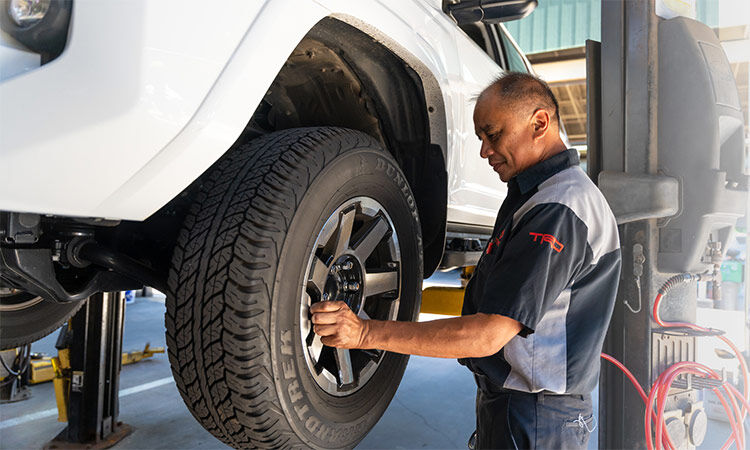Unlock Efficiency: Expert GMC Tire Service at Morris Tires
Unlock Efficiency: Expert GMC Tire Service at Morris Tires
Blog Article
Tire Solution: The Impact of Weather
When it comes to guaranteeing optimum performance and security on the road, comprehending the effect of weather conditions on tire solution is vital. GMC Tire Service. In this discussion, we will explore the detailed relationship between climate problems and tire service, losing light on the value of weather-specific tire upkeep techniques and factors to consider.
Heat and Tire Efficiency
When revealed to high temperatures, tires experience changes in performance that can substantially affect lorry safety and handling. The warm produced from extended driving or warm climate conditions causes the tire rubber to soften, leading to minimized step life and enhanced wear.

Cold Weather Effects
Cold weather problems can have a considerable impact on tire performance and safety and security. In cold climate, tires may likewise lose air stress more quickly, which can impact taking care of and fuel effectiveness.
To alleviate the impacts of cold weather on tires, it is essential to regularly inspect tire stress and inflate them to the maker's recommended levels. Using winter season or all-season tires made for cold weather conditions can also boost traction and grip on icy or snowy roads. Proper tire maintenance, consisting of routine examinations for wear and damages, becomes much more crucial throughout cooler months to ensure optimal performance and security.
Rainy Issues Influence
During rainy problems, tire efficiency and safety can be substantially influenced by the wet road surfaces and lowered exposure. The step pattern of tires plays a crucial duty in keeping grip on damp roadways. Tires with damaged treads are extra prone to hydroplaning, where a layer of water builds up in between the tire and the roadway surface area, resulting in loss of grip. To fight this, chauffeurs should consistently check their tires for sufficient walk depth and take into consideration purchasing tires particularly developed for damp conditions.
Furthermore, wet climate can also lower presence, making it testing for chauffeurs to see the roadway in advance clearly (GMC Tire Service). In such conditions, it is necessary to readjust driving rates as necessary and preserve a secure following distance to permit unexpected quits. Appropriately filled with air tires can additionally aid in maintaining control on wet roadways by giving better handling and hold
Snow and Tire Safety And Security
When driving in snowy problems, having the best tires can make a considerable distinction in security and performance. Winter months tires are designed with special rubber compounds and tread patterns to supply far better grip on snow and ice contrasted to all-season tires.

It is important to follow producer guidelines when installing and using tire chains to stop damages to the tires and lorry. By picking the best tires, maintaining proper rising cost of living, and taking into consideration added traction aids like tire chains, chauffeurs can boost their safety when navigating snow-covered roadways.
Weather-Related Tire Upkeep
When encountered with numerous weather, correct tire maintenance becomes an essential aspect of vehicle safety and security and performance. Weather-related tire maintenance includes a variety of techniques intended at making certain ideal tire feature and durability learn the facts here now in different climate circumstances. One key facet of weather-related tire upkeep is tire stress policy. Fluctuating temperatures can cause tire pressure to differ, impacting traction and fuel effectiveness. Routinely checking and changing tire stress according to manufacturer suggestions is important for secure driving in transforming climate condition. In addition, tire step depth plays a substantial duty in handling various weather condition aspects. Tires with appropriate step depth give better grip on damp or icy roadways, lowering the threat of hydroplaning or skidding. When tread wear reaches a certain depth is vital for keeping grip and security in negative climate, evaluating tire step routinely and replacing tires. By prioritizing weather-related tire maintenance, chauffeurs can enhance security, enhance car performance, and prolong the lifespan of their tires.
Final Thought
In final thought, climate condition have a considerable effect on tire performance and safety and security. From heat influencing tire pressure and wear to chilly weather condition reducing grip, it is important to take into consideration the weather condition when keeping and utilizing tires. Rainy problems can decrease hold and bring about hydroplaning, while snow can boost the threat of crashes if tires are not appropriately geared up. Weather-related tire maintenance is crucial in ensuring optimal efficiency and security when driving.
In this discussion, we will explore the complex partnership between weather condition problems and tire solution, losing light on the relevance of weather-specific tire maintenance practices and considerations.

Report this page